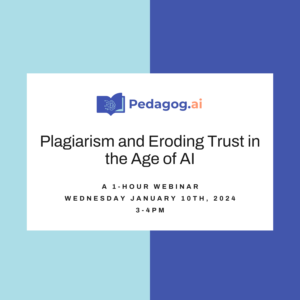Jan. 10, 2024, from 3 PM to 4 PM, ET

Explore the rapidly-evolving discussion on plagiarism in the classroom brought on by the invention of Generative AI!
There are a variety of ways that Generative Artificial Intelligence (GenAI) can be used to engage in academic dishonesty. This discussion is complicated by the nuance and ambiguity in definitions of plagiarism across different academic institutions. However, here are a few examples from industry leaders on how GenAI can be used in ways which initiate and promote behavior constituting academic dishonesty.
GenAI has been shown to fabricate titles and links to sources. Per Arkansas State University, “ChatGPT will completely make up citations to "support" the text it generates. Here, in our library, we've already encountered multiple instances of faculty and students looking for books and articles that don't exist”.
Without proper citation, the duplication of content originally produced by ChatGPT or other GenAI tools is often considered plagiarism. This sentiment was echoed by ChatGPT itself, as reported in this article by the University of South Florida’s library.
From St. Edwards University , ”Generative AI derives its output from previously created texts from other sources that the models were trained on, yet doesn't cite sources”. This means it is possible that AI tools are reproducing content in their outputs that, if AI was not being used, would need to be cited by students.
The rapid rise in AI use in and out of the classroom has led teachers to ask a series of new questions– should the use of artificial intelligence by students be cited? If so, how should these external resources be credited in academic works?
These questions open up a new, confusing, aspect to the assessment of student work. Fortunately, a variety of resources are available for educators from internationally- recognized organizations which help answer these questions. These resources are summarized here, but for more information, please refer to Pedagog.ai’s blog post on AI citation.
In-text citations:
Reference list:
Summary:
In-text citation:
Reference list:
Read more here!
Summary:
Footnotes:
To learn more, check out this blog post.
This blog post lists the current AI use policies and guidelines of specific AP courses and programs.
Summary:
The IB program embraces AI use, and understands its immerse potential to enhance learning.
For more information, please refer to this article.
Many educators are extremely wary about how students are using Generative AI tools in their work. This discomfort has led to a reliance on newly-developed AI Detector Tools: programs which advertise themselves as foolproof revealers of AI-generated content. However, while these AI detection tools continue to improve, they are prone to biases and inconsistencies which can falsely punish honest student work and send educators on a destructive witch hunt which deteriorates classroom trust.
While it is natural for educators to feel apprehensive about students’ AI use, they should instead focus their attention on promoting student-driven work, leading in-class discussions about AI use, and reframing syllabi and curriculums to handle the modern classroom.
False. The newest version of ChatGPT (called “GPT-4 Turbo”) has been updated to include information and news as of April 2023 (source: zdnet.com ). There is also an internet-browsing feature which allows users to browse Microsoft’s Bing, accessing up-to-date information and nearly real-time news updates.
False. Though many educators assume they can recognize students’ writing styles well enough to decipher whether their student enlisted aid from GenAI tools, newer GPT models allow students to train them using their written voices, making it more difficult than ever before to detect whether or not students are using AI tools in their work. GenAI can also effectively mimic human voices, actions, and even handwriting style, as was proven at Abu Dhabi’s Mohamed bin Zayed University of Artificial Intelligence.
False. Though early Generative Artificial Intelligence systems notoriously performed poorly in elementary math problems, this is no longer the case. Current AI-systems have the ability to outperform humans in a variety of math-related operations, including in this Scientific American article. ChatGPT’s newest and currently unreleased model, named “Q*”, is rumored to be able to solve grade-school level math problems reliably and efficiently, a development which has the potential to severely alter the overall breadth of Generative AI’s capabilities.
False. Some educators worry that reliance on AI for research and writing hampers the development of students’ research skills. However, when used correctly, AI can aid in teaching effective research techniques, such as identifying credible sources, synthesizing information, and organizing thoughts, provided that students are guided on how to use these tools ethically and efficiently.
False. There’s a concern that AI’s ability to generate essays and reports could make teaching writing skills unnecessary. On the contrary, AI can be used as a tool to enhance writing instruction, by providing examples, helping with brainstorming, and offering feedback on grammar and style. Educators play a critical role in teaching students how to critically engage with and improve upon AI-generated drafts.
False. There’s a fear that students will use AI to avoid learning processes. In reality, AI can be integrated into learning in ways that deepen understanding, such as through interactive problem-solving or creating more engaging, personalized learning experiences. Teachers can leverage AI to enhance, rather than replace, traditional learning methods.
To learn more about the ongoing discussion about Plagiarism in AI, please click one of the links below to access articles written by news outlets and industry professionals:
To explore state and federal guidance on AI, as well as to access examples for how to frame Artificial Intelligence in the classroom, please refer to Pedagog.ai’s AI Education Policy Landscape and accompanying research report.
Access our tools, lesson plans for AI integration & literacy, our prompt library, and webinars and courses through your account!